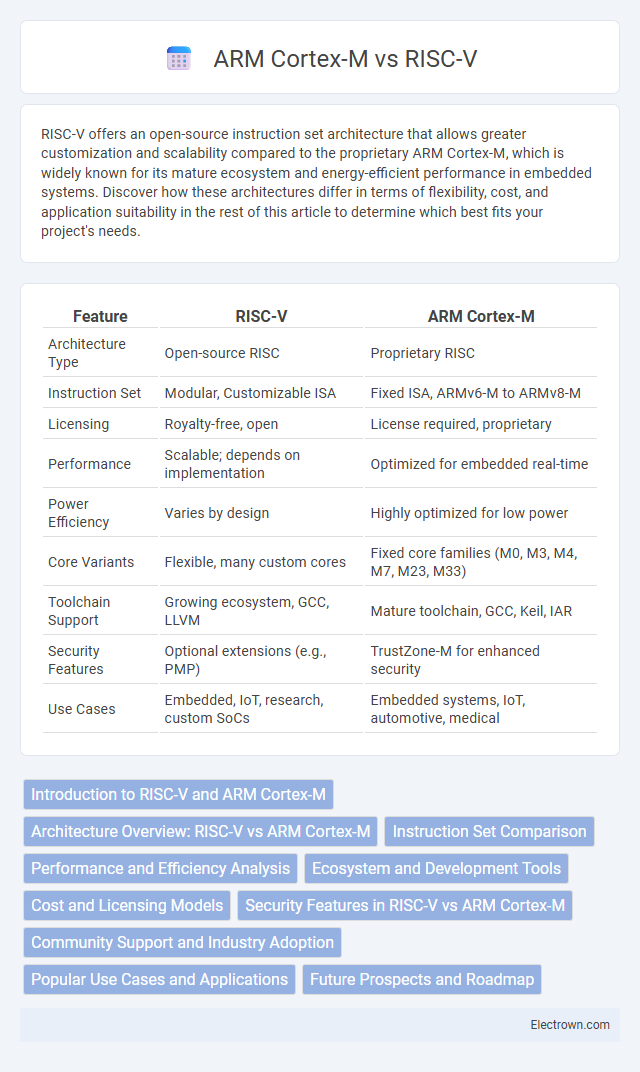RISC-V offers an open-source instruction set architecture that allows greater customization and scalability compared to the proprietary ARM Cortex-M, which is widely known for its mature ecosystem and energy-efficient performance in embedded systems. Discover how these architectures differ in terms of flexibility, cost, and application suitability in the rest of this article to determine which best fits your project's needs.
Table of Comparison
| Feature | RISC-V | ARM Cortex-M |
|---|---|---|
| Architecture Type | Open-source RISC | Proprietary RISC |
| Instruction Set | Modular, Customizable ISA | Fixed ISA, ARMv6-M to ARMv8-M |
| Licensing | Royalty-free, open | License required, proprietary |
| Performance | Scalable; depends on implementation | Optimized for embedded real-time |
| Power Efficiency | Varies by design | Highly optimized for low power |
| Core Variants | Flexible, many custom cores | Fixed core families (M0, M3, M4, M7, M23, M33) |
| Toolchain Support | Growing ecosystem, GCC, LLVM | Mature toolchain, GCC, Keil, IAR |
| Security Features | Optional extensions (e.g., PMP) | TrustZone-M for enhanced security |
| Use Cases | Embedded, IoT, research, custom SoCs | Embedded systems, IoT, automotive, medical |
Introduction to RISC-V and ARM Cortex-M
RISC-V is an open standard instruction set architecture (ISA) known for its modularity and extensibility, enabling custom implementations tailored to specific applications. ARM Cortex-M cores are a family of energy-efficient, 32-bit microcontrollers designed for embedded systems, widely adopted due to robust ecosystem support and optimized real-time performance. Your choice between RISC-V and ARM Cortex-M can impact flexibility, development cost, and compatibility with existing software tools.
Architecture Overview: RISC-V vs ARM Cortex-M
RISC-V offers an open-source, modular instruction set architecture (ISA) with a simplified design that promotes customization and scalability, while ARM Cortex-M features a proprietary, fixed ISA optimized for low-power and real-time embedded applications. The RISC-V architecture allows developers to add custom extensions tailored to specific needs, enhancing flexibility compared to the more standardized and widely supported ARM Cortex-M cores. Your choice between these architectures depends on whether you prioritize open innovation and extensibility or established performance and ecosystem integration.
Instruction Set Comparison
RISC-V features an open-source, modular instruction set architecture (ISA) that allows for customizable extensions tailored to specific applications, promoting flexibility and innovation. ARM Cortex-M utilizes a proprietary, fixed ISA optimized for energy efficiency and real-time performance in embedded systems, supporting a rich set of instructions including Thumb and Thumb-2 for code density. The RISC-V base ISA is simpler and extensible, whereas ARM Cortex-M combines a complex instruction set with efficient instruction encoding to balance performance and low power consumption.
Performance and Efficiency Analysis
ARM Cortex-M processors deliver high performance with efficient power consumption, optimized for embedded applications requiring real-time responsiveness and low energy use. RISC-V architecture offers customizable instruction sets enabling tailored performance enhancements and potential efficiency gains specific to application needs. When evaluating your project, consider ARM's mature ecosystem and power-optimized silicon versus RISC-V's flexibility for innovation and cost-effective scalability.
Ecosystem and Development Tools
RISC-V offers an open-source ecosystem with growing community support and a variety of free and customizable development tools, fostering innovation and flexibility in embedded design. ARM Cortex-M benefits from a mature and extensive ecosystem, featuring robust toolchains, comprehensive middleware, and widespread vendor support, ensuring reliability and ease of integration for your projects. Choosing between RISC-V and ARM Cortex-M depends on your need for open architecture customization versus established tool stability and ecosystem breadth.
Cost and Licensing Models
RISC-V offers a royalty-free, open-source instruction set architecture that significantly lowers development costs and provides flexibility in customization compared to ARM Cortex-M's proprietary licensing model. ARM Cortex-M requires licensing fees and intellectual property agreements that can increase expenses for manufacturers and limit design modifications. Your choice between the two will impact long-term cost efficiency and control over processor integration in embedded systems.
Security Features in RISC-V vs ARM Cortex-M
RISC-V incorporates customizable security extensions such as Physical Memory Protection (PMP) and supports Secure Enclaves through the Keystone framework, enabling fine-grained access control and isolation. ARM Cortex-M processors feature TrustZone technology, which creates a secure execution environment by partitioning hardware resources to separate trusted and non-trusted code, along with integrated cryptographic accelerators for enhanced protection. The open-source nature of RISC-V allows for tailored security implementations, whereas ARM Cortex-M offers standardized, widely tested security features suited for embedded and IoT applications.
Community Support and Industry Adoption
RISC-V benefits from a rapidly growing open-source community, driving innovation and broad industry collaboration, while ARM Cortex-M boasts decades of established support from major semiconductor companies and extensive ecosystem tools. Your choice might depend on RISC-V's flexibility and emerging market presence versus ARM's mature software stack and widespread adoption in embedded systems. Both platforms have strong industry backing, but ARM Cortex-M maintains a larger installed base in commercial applications.
Popular Use Cases and Applications
RISC-V architecture excels in customizable embedded systems, IoT devices, and academic research due to its open-source nature, allowing you to tailor processors for specific applications. ARM Cortex-M cores dominate in low-power, real-time embedded systems such as automotive controls, wearable technology, and consumer electronics, benefiting from extensive software ecosystem and industry adoption. Both architectures support efficient microcontroller implementations, but RISC-V is rapidly growing in innovation-driven sectors while ARM maintains strong footholds in mass-market, power-sensitive environments.
Future Prospects and Roadmap
RISC-V's open-source architecture offers unparalleled flexibility and scalability, making it a strong contender for future embedded systems and IoT applications, while ARM Cortex-M maintains a robust ecosystem with extensive industry support and proven reliability. The RISC-V roadmap emphasizes customization and innovation, enabling developers to tailor processors to specific needs, whereas ARM Cortex-M focuses on continuous performance improvements and power efficiency in its future iterations. Your choice between RISC-V and ARM Cortex-M should consider long-term support, ecosystem maturity, and specific application requirements to align with evolving technology trends.
RISC-V vs ARM Cortex-M Infographic

 electrown.com
electrown.com